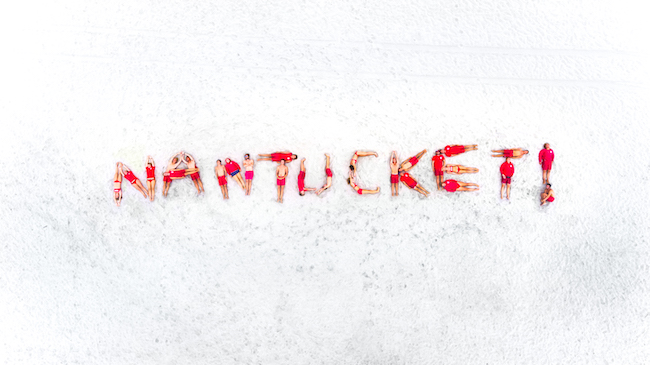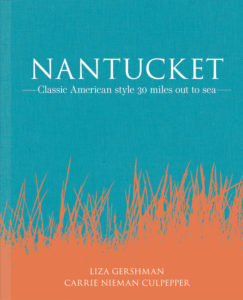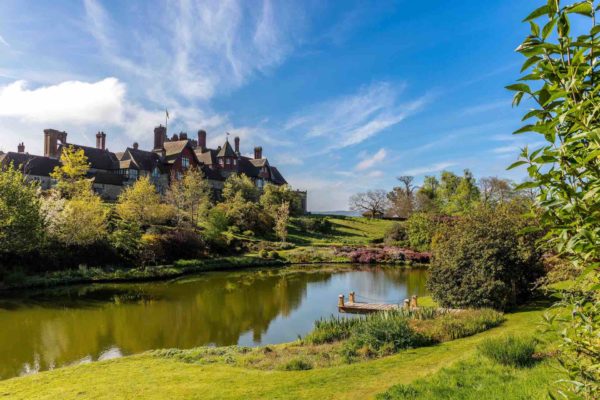‘Nantucket: Classic American Style 30 Miles Out to Sea’ by authors Liza Gershman and Carrie Nieman Culpepper features natural photographic portraits and environmental stills so captivating, you can almost hear the waves crashing off the North Shore. From delicious lobster rolls to timeless interior design, island customs and activities, this new book also invites you to meet the locals who call Nantucket home.
By authors Liza Gershman and Carrie Nieman.
Nantucket means “faraway island” in the language of the Wampanoag tribe who first inhabited the land. Throughout its last 400 years, the boomerang-shaped island has always required a healthy dose of determination, perseverance, and means, either financial or cunning, to step onto its shores. Even today it’s undeniably an effort to arrive, requiring boat or plane, and often a long-haul journey in the car before that. To come to Nantucket is a purposeful choice. Arriving feels earned, worth celebrating. The fastest ferry is still an hour from mainland Massachusetts, and flights from Hyannis (when they aren’t grounded by fog) are a bumpy twenty-minute ride. But it is worth the effort to get here and settle into the scene: plentiful beaches, hundreds of species of birds, the sunsets of paintings, and a community of smart, charismatic, creative people all contribute to the magic. And that aura of intention and love for the island shows. This tight-knit community of achievers, dreamers, and rebels has created an enviable lifestyle and aesthetic that’s an amalgamation of the people, historic grey-shingle homes, and the 14-mile-long island itself; its wind, sea, and wild landscape.
Nantucket has shaped its people and they’ve developed a unique life 30 miles out to sea. The look, feel, and culture that define what’s classic about American style in many ways began here, and Nantucket continues to push cultural boundaries because of influences drawn from around the world, innovative thinking, hard work, and a shared love for the beautiful lifestyle one can have here.
READ THE NANTUCKET ARTICLE IN THE TILDA SWINTON EDITION
As Nantucket has always been a notoriously difficult place to get to. This has helped it develop and maintain a character all its own. Now more than 11,000 year-round residents inhabit the island, and summer families, no matter where they arrive from—Boston, Chicago, Washington D.C., Greenwich, or San Francisco—all subscribe to its unwritten rules. Many residents slip on colourful sundresses, break out their boat shoes, sun-bleached L.L.Bean bags, and proudly add another beach permit to their vintage Land Rover each season. This is not a self-conscious style capital, absorbed in labels and trends. Quite the opposite. Instead, style here is shaped by wind, cobblestones, cliffs, beaches, sailboats, surfboards and, for a long time, the blue-blood idea that showiness is less tasteful than something practical that’s tattered and aged by the sun. The island’s inaccessibility has preserved the look, which is equal parts blue blazer, decade-old Sperry Top-Siders, and salty Mount Gay cap earned at a regatta. In just the last few years, the barrier to get to Nantucket has lifted some. Flights into ACK (the famed airport code) have brought more visitors from New York and other East Coast cities, and many more people live year-round than ever before. Yet the island’s steadfast ethos and aesthetics prevail.

Individualism still reigns
For its first 200 years of European settlement, Nantucket sea captains went out exploring the world. For the last 200, the world has come to Nantucket, and this sentiment is echoed at the Nantucket Historical Association’s Whaling Museum.
From Nantucket’s start as a settlement of liberal entrepreneurs who escaped their Plymouth Colony brethren’s narrow mindedness, later embracing Quaker egalitarianism, Nantucket’s individualism and self-reliance can still be seen today in its year-round artists and makers carving a life on the windy, foggy faraway island. For a tiny place, Nantucket holds a powerful role in shaping American culture and style.
One of the United States’ most significant ports during the eighteenth and nineteenth centuries, Nantucket’s sea captains journeyed to the Orient, Africa, Europe, and the far corners of the world to trade whale oil. They returned with wealth, stories, and souvenirs. Today, Nantucket is often only thought of as an idyllic natural playground for the American elite, but its inhabitants are varied and the island is home to many international residents, including those from the Dominican Republic, Costa Rica, Jamaica, Nepal, Sri Lanka, Russia, and elsewhere.
“The first person from my hometown to come to Nantucket was a woman named Victoria,” says Diony Gil, a successful builder. “Because of her, more than 200 people from Cabrera, Dominican Republic, are here now raising families and living year-round. A friend who was building the post office told me to come help for the summer and one summer turned into thirteen years.”
Diony’s story is not uncommon. Many come to Nantucket for the summer and stay for a lifetime. “The island is so quiet, I feel safe here,” he says, describing leaving the house unlocked and keys in the car. “I never had that experience anywhere else.” Diony, like many, loves the tranquility, and the community. “Everyone knows each other here and it’s like a big family,” he smiles. Of course, the people make the place.
Islanders, washashores, and summer residents
For many, the island gripped them from their first visit, like New Yorker Betsy Hussey, fashion director at Calvin Klein, who spent the summers of her youth on Cape Cod, but fell in love with Nantucket’s island aesthetic as an adult and rented for many years before buying a small cottage. “It’s been a dream,” she says, from her minimalist office in Manhattan’s garment district. “It’s very stabilising having that cottage. You feel totally different there, you feel… far away.”
Marcus Foley grew up in Jamaica and came to Nantucket one college summer with friends and felt an immediate connection because of the island lifestyle and, at the time, the Jamaican population of summer help. Now an artist, Marcus lives on-island with his wife and two boys, carving whales and other creations out of driftwood and selling them at the Farmers Market and via Instagram.
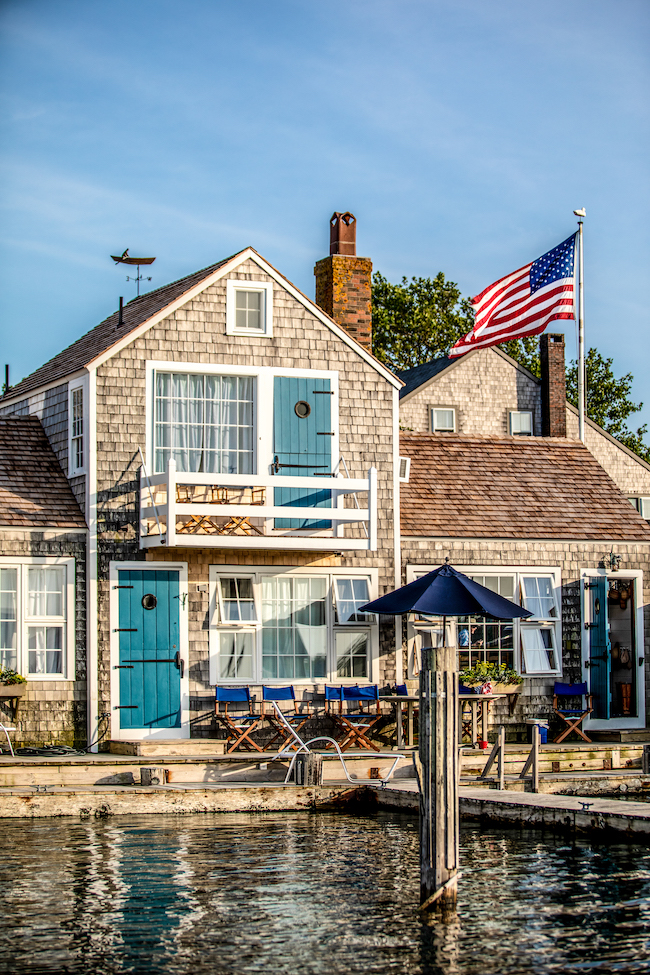
Sara Rossi found opportunity on Nantucket, a place she summered all her life. She and Taylor Ivey opened the Skinny Dip on Old South Wharf as a collective of independent brands rooted in the preppy aesthetic. The store took off and in just three years the duo has opened Skinny Dip locations in Charleston and Palm Beach: a testament to the Nantucket aesthetic beyond its shores (not to mention the island’s power as a retail incubator).
Thomas L. Macy has spent his whole life summering on Orange Street, and now lives there half the year. His direct relative, many generations ago, Thomas H. Macy, was one of Nantucket’s first European settlers arriving in 1659. Tom is a fifth-generation Macy to live on Nantucket and he spends his time reading, boating, and at the Nantucket Yacht Club and Wharf Rats club swapping sailing stories with the island’s old-timers.
Both summer residents and islanders speak of the magic of Nantucket. Not just the beauty and charm but the embracing community and the plentiful support for the arts. These people, and others we’ll meet, are of disparate backgrounds who shape the distinct American style on Nantucket island. These people are the island, its champions, caretakers, investors, creators, craftspeople. They include business owners and CEOs, chefs and servers, builders and gardeners, designers and makers, sailors, and even rebels. And more often than not, they’re friends, too. Welcome to Nantucket.
Rebellious stock: whalers, Quakers, artisans, entrepreneurs
The island has always been a talisman for ambition. Those lucky enough to hear legend of its opportunities or peek at its possibilities still need a healthy dose of rebel to pull off life, and work, on this 30-mile-out spit. It’s one of the throughlines of Nantucket history. From the whalers of the eighteenth century to the entrepreneurs and foreign-born workforce of today. Who washes up on Nantucket is a fascinating group; a true mixture of those who epitomise capitalism and those who are bohemian enough to live out of the mainstream. The island offers possibility for the ambitious willing to take the risk, and willing to work for it.
Once you get to talking with washashores, you notice a common theme. It may be desire for independence, as it was for the Quakers, or to start a business, or embark on an adventure. Whatever the reason the island represents opportunity to separate from the mainland, make money and live with less convention, without a rat race, strip malls, pollution, crime, or stop lights. With nature, history, community and possibility. Surfers can run a school and take off to Costa Rica for the winter. Artisans can sell their work to tourists from all over the world and hole up in their studios with the quiet and headspace to create in the off-season. Restaurateurs can pack them in over the summer then shutter in the winter and seek inspiration in far-flung lands. Creatives and entrepreneurs use the off-season to energize and refuel off-island with Nantucket’s seasonal lifestyle. And the island’s many influential summer visitors offer ideal exposure for brands and businesses looking for a launchpad.
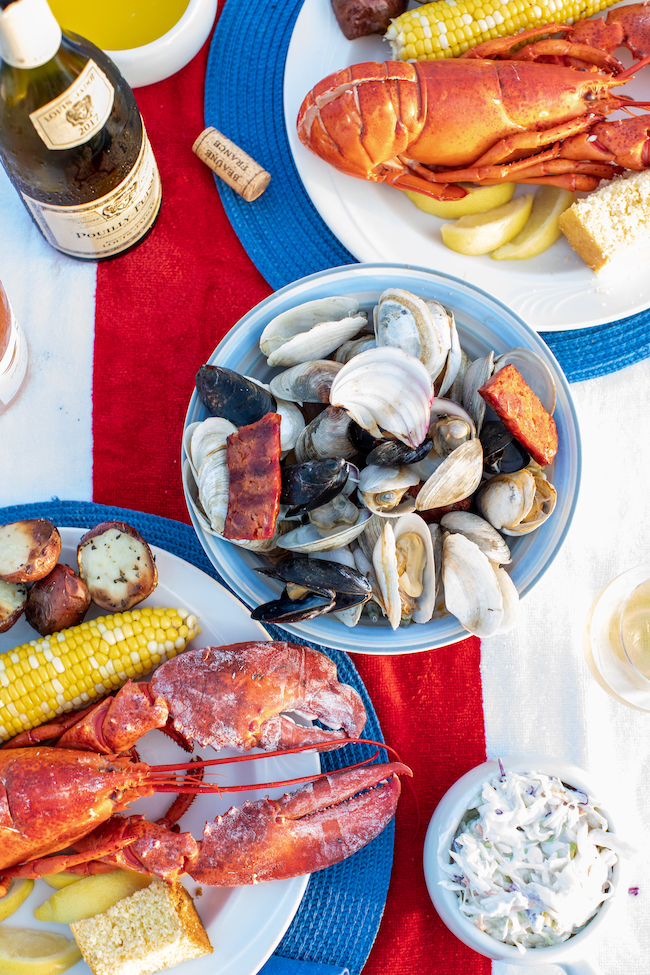
While the rest of the country is taking summer Fridays and barbecuing with family and friends, most Nantucket islanders are working nonstop in what is their condensed ninety-day earning period. Nantucketers with island-based businesses do not get a break during the summer, not even weekends off—and have to be savvy enough to manage seasonal businesses with drastic differences of crushing summers and dormant winters. Budgeting, staffing, housing, planning, and managing expectations of the elite resident and traveller are not for the casual business owner. But hard work can yield an idyllic life on this island incubator. So much so that some talk of their children’s hesitance to leave. Who could blame them when they are surrounded by such beauty, nature, and the fun of seasonal friends enjoying their carefree vacations each summer, along with the influence and potential the summer folks bring to island ideas and institutions.
The Nantucket Cottage hospital foundation was able to raise $120 million in three seasons thanks to the generosity of islanders and many affluent summer residents. Between the Nantucket Golf Club and Nantucket Yacht Club they reward five Nantucket High School seniors full, four-year tuition to the college of their dreams. The Nantucket Boys and Girls Club is operating in a brand new, multimillion-dollar facility thanks to island generosity. The possibilities and perks are there for those willing to hear the island’s siren call.
Finding Inspiration: actors, artists, authors and creatives.
The isolation of island life and the wild beauty that surrounds you on Nantucket are natural magnets for the many actors, artists, authors, and other creatives. And the added bonus of being able to find backing or gain exposure to influential inhabitants can make Nantucket life fruitful for creatives.
Nantucket has a long history of attracting creatives. Around the turn of the last century, when theatres would close down for the summer, a group of the Broadway community would descend upon Nantucket’s Siasconset (or ’Sconset) neighbourhood to live in beach cottages and stage productions by the sea. The “Actors Colony” as they became known, eventually built the ’Sconset Casino for performances and recreation. The tradition continues across Nantucket’s theater groups, such as Theatre Workshop of Nantucket, Dreamland Stage Company, and White Heron Theatre Company. In some cases, idle summering teenagers can work on productions with professionals—an opportunity they wouldn’t likely have at home. Nantucket’s small size begets access.
Thanks to arts patrons, several incubators ensure artists continue discovering and being inspired by the island. Philanthropist and arts advocate, John S. Johnson, founder of BuzzFeed, son of sculptor Seward Johnson (and great-grandson of Robert Wood Johnson, co-founder of Johnson & Johnson) founded an artists’ colony and screenwriters’ colony operating out of a family compound with a 100-year-old barn. Johnson brings in artists from around the world for his colonies, which are run by local creatives, where colonists attend events and interact over dinners with Nantucket’s many creative practitioners. “The island is still chock- full of interesting people,” he says.

It’s easy to find inspiration on Nantucket, says printmaker Eric Holch. “Go to Newport, Rhode Island, and drive the backroads and you’ll go past Jiffy Lubes and gas stations. Here it’s still unspoiled.” Holch, who left New Canaan, Connecticut, and a successful advertising career to pursue his side project making art, pulls direct inspiration from island life: its sailboat races, beaches, gardens, and lighthouses.
Landscape painter Illya Kagan, the son of famed furniture designer Vladimir Kagan and needlework artist Erica Wilson, also sees the island as muse. In Kagan’s case, it’s the unique topography, which includes poetic natural elements such as acres of moors, rolling plains patched with wild grasses, long stretches of open beach, and a particular, rounded cobblestone that gives Nantucket Town an unmistakable aura of the past.
Beyond the direct visual inspiration, many island artists thrive off the natural surroundings, and report that the solitude of winter provides ideal time in the studio, or for creative development, while island summers bring influential backers and patrons.
“For friends of mine living on the island, anyone with any kind of creative practice, I think there’s a freedom in Nantucket’s isolation that’s pretty glorious,” says Johnson. “Then what is so cool is you have that freedom combined with the stimulation of connection in the summer when there’s this great influx of people and you’re going to a dinner party meeting somebody interesting, or seeing somebody downtown that’s a friend of a friend. There aren’t a ton of places where you can have both of those things.”
The world still comes to Nantucket, or at least its powerful creatives and captains of industry. Summer visitors last year have included many Fortune 100 CEOs, politicians like Joe Biden, and even the Hollywood set, Gwyneth Paltrow and Drew Barrymore. Its summer residents include Ambassador Elizabeth Bagley, former Google CEO Eric Schmidt, philanthropist Wendy Schmidt, the late Jack Welch (former GE CEO) and journalist/philanthropist Suzy Welch, architect Graham Gund, Chanel Vice-Chairman Arie Kopelman, New England Patriots coach Bill Belichick, actor Jerry Stiller, and many others. The year-round population has some of its own creative fame: New York Times best-selling author Elin Hilderbrand has penned her twenty-six romance novels (most set on Nantucket) from beaches and poolsides. Nathaniel Philbrick writes historical nonfiction rooted on Nantucket’s history, his National Book Award-winning ‘In the Heart of the Sea’ was recently turned into a movie directed by Ron Howard.
Even when the island doesn’t foster wider fame it can bring exposure. For Nantucket musician and music producer Floyd Kellogg, when big-name artists come to record or play at the island’s iconic club, The Chicken Box, but don’t want to incur the expense of bringing their whole band, Floyd often stands in. He’s had the opportunity to play with members of the Red Hot Chili Peppers, Florence and the Machine, G. Love & Special Sauce, and others. Being a big fish in a small pond does have its advantages, especially when New York is now just a Jetblue flight away.
Actor-director John Shea, known for his many roles in television and movies, including Gossip Girl and Lois & Clark, and award- winning work on Broadway, has maintained a fifty-year love affair with the island. Shea originally came as a college student, later returning as a Yale School of Drama graduate and young hippie, and for the last decade living year-round with his artist-wife Melissa MacLeod and their two children. Shea enjoys appearing in island productions—notably Orson Welles’s Moby Dick—Rehearsed, which he performs annually under a 50-foot sperm whale skeleton suspended from the rafters at the Nantucket Whaling Museum—but also regularly travels off-island for work and inspiration.
“In mid-winter we retreat, Nantucket people love to travel,” says Shea. “Friends of mine will say, ‘I was skiing in the Swiss alps, I was just in Sri Lanka, or I was scuba diving in Turks and Caicos, or I was riding horseback in Patagonia.’ They’re doing crazy things like this all over the world all the time. And if you’re a restaurateur, you’re bringing menus and recipes and spices that you found in a souk in Morocco and you’re adding it to your ingredients. And if you’re a painter or a photographer you’re bringing back images from around the world. If you are a writer, you’re inspired by what you just experienced when you were on a pilgrimage in India. That kind of thing also makes the island really rich culturally.”


